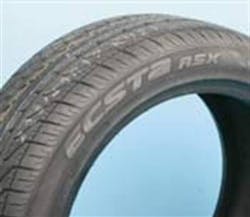People buy performance vehicles because they want to enjoy their vehicle to the fullest extent. Maybe they want to experience the thrill of horsepower, torque, handling or braking -- or a combination of all of them.
In theory, a performance vehicle should accomplish various tasks much more efficiently than would a run-of-the-mill car, truck or SUV. Choosing the correct performance tire for the vehicle will help accomplish this. It will not only enhance any performance vehicle, but also enable "normal" vehicles to experience a higher level of performance.
All tires are designed with a range of performance attributes. While a specific tire may perform admirably in all general driving conditions, each model of tire usually will excel in one area -- whether that involves dry road grip or wet weather handling, high heat or extreme cold, snow or ice, etc.
In other words, even though a tire may handle and grip well in both dry and wet road conditions, its optimum performance may be targeted at either wet or dry road surfaces. Likewise, a tire may be designed to perform well in most conditions, but targeted to provide outstanding performance in snow/ice/cold environments.
If the customer and vehicle application requires "very good" performance in all weather conditions, an all-season type of tire will be perfectly acceptable. However, if the customer wants the absolute best performance possible, he or she should decide under what conditions that extremely high level of performance will be expected. These expectations may require a dedicated set of "summer" and "winter" tires.
Many customers confuse great wet weather grip with great snow/ice grip, which are two performance aspects that are contradictory. If a high performance tire is designed for outstanding wet weather traction, this does not mean that the same tire will provide high grip in colder temperatures on snow or ice.
[PAGEBREAK]
WINTER TIRE INSIGHT
As but one example of how a design element can affect grip, let´s look at styrene and how it can react to changes in temperature. Styrene is the primary polymer used in tread compound formulation. It is essentially a plastic material. Additives are used to soften and tailor the styrene for optimum grip performance when design-targeting specific temperature ranges.
If the compound is formulated for best grip in, say, a temperature of 70 degrees Fahrenheit, when subjected to a colder temperature (let´s say 10 degrees F), the styrene then hardens and becomes more "plastic," providing reduced grip in colder weather conditions. Conversely, if the styrene package is mixed for optimum grip when the temperature is 10 degrees F, it may become too soft for optimum grip in warmer weather.
So even though the consumer may relate any "slippery" road condition (wet or snow) as similar, if optimum grip is desired, the tires will differ. (Of course, all-season tires offer a compromise in performance characteristics, since the tread compound is formulated to operate over a wider temperature band.)
As you can see, the technology employed by today´s tiremakers is nothing short of phenomenal. In the case of winter tires, tread designs and compounds have developed by leaps and bounds.
However, many people make the mistake of assuming that they only need "winter" tires on the vehicle´s drive axle. It´s extremely important to always run the same type of tire at all four corners. If you run "summer" tires on a non-drive axle and "winter" tires on the drive axle, grip and handling characteristics will differ between the two types of tires.
If you mix tires from axle to axle, the vehicle won´t react properly, especially in emergency situations, when the vehicle may either understeer (front end push) or oversteer (rear end loss of control). Make sure your customers know the importance of always running a full set of the same tire model at any given time.
[PAGEBREAK]
COMPOUNDS & TREAD
A tire´s "cap" compound (tread area that makes contact with the road) is tailored for specific weather/temperature range operation by its formulation and the use of various polymer technologies. In addition, the tread design itself may be tuned specifically for fast water evacuation (for optimum wet weather driving), or a multitude of small sipes may be present to aid traction in snow and ice conditions.
Tread designs also can be arranged, via the placement, angle and pitch of tread blocks and grooves, to eliminate or reduce harmonic noises or air compression noises on dry road conditions.
A directional tread design may be incorporated for improved wet weather traction, or a unidirectional tread design might be employed for increased wet weather or snow/ice performance. The tread design might take advantage of offset (asymmetric) tread design for enhanced grip on wet roads, while simultaneously providing outer tread areas that provide decent dry road grip. The angle of belt placement can be tuned to affect progressive handling characteristics as well as ride quality.
As you can see, a wide range of variables, in terms of tread compounds, tread designs, bead assembly construction, belt material and orientation and undertread characteristics, can be utilized to move a tire´s optimum performance capabilities toward optimum dry, wet, snow or ice conditions. Depending on what characteristics the customer wants, a tire can be selected that will provide the specific performance required for specific driving conditions. These parameters, as part of the selection process, would include characteristics that involve:
* steering response rate,
* noise level,
* road grip (dry and wet),
* high speed stability,
* cold weather/snow/ice performance,
* anticipated tread life (tread durability), and
* ride comfort.
A tiremaker might enhance a tire for ultra-high performance characteristics in a range of driving conditions by using a high dry-grip tread compound on the shoulder areas, combined with a balanced dry/wet/light snow and cold tread compound between the shoulders, and a wet traction compound at the center tread rib. In effect, this would be an example of a high performance "all-season" tire that may perform to the driver´s expectations in all but severe cold/snow/ice conditions.
Since the goal is to balance road control with weather-tuned performance, the customer must decide under what conditions he or she expects the tire to perform at its best. For example, many original equipment tires are tuned for reduced rolling resistance and not necessarily for optimum traction. If the driver wants the best performance available in specific road conditions, he or she may need to purchase one set of tires for summer use (optimized for dry and wet traction) and a different set of tires for cold weather.
If the customer does not wish to attain optimum performance in any specific set of driving conditions, but prefers to run the same set year-round, a high performance all-season tire may provide the best choice.
[PAGEBREAK]
TARGETED TREAD TUNING
In terms of tread design, optimum dry grip relies as much on road contact area as possible. If dry grip were the only consideration, a slick tread with sufficient thickness for wear durability would be best. But a slick isn´t viable for the street because you never know when it´s going to rain. This is why an ultra-high performance or high performance tire that´s tuned primarily for dry grip will feature large tread block areas -- with enough grooves to allow for acceptable water evacuation.
A performance tire that´s tuned to achieve optimum wet grip will feature large water routing grooves designed to provide a quick escape path for water in order to prevent hydroplaning.
A performance tire destined for the best grip in snow will feature numerous small sipes that provide opening/closing (chew and spit) characteristics, in addition to voids between the sipes and tread blocks to allow the snow to be evacuated. On any tire designed for serious snow conditions, the challenge is to avoid "fouling" of the grooves and sipes, where deep snow might be packed.
A more aggressive number of voids may be required to kick the snow out of the tread as the tire tread surface rotates and leaves the road. For extremely soft surfaces, like snow or sand, an increase in tread block and sipe "edging" may be needed, with circumferential edges for straight-line traction and lateral edges for handling in turns.
TRACTION CONTROL AND ABS
If the vehicle features traction control, there´s no reason to fret about selecting tires that will or won´t work properly with that system. Traction control simply prevents the driver from "over-powering" the tires by limiting or eliminating wheel spin during acceleration. Brand or model of tire won´t cause a problem with a traction control system.
Likewise, if the vehicle features ABS (anti-lock brake system), the selection of tire make/model is a non-issue. The only concern involves overall tire diameter, since the ABS will be programmed to work properly within a specific tire diameter range. The acceptable tire diameter deviation varies between auto makers, with acceptable ranges running from a 3% to 15% tire diameter change.
If the overall tire diameter doesn´t change, the ABS won´t be affected. This is yet another reason to follow the Plus concept (Plus-Zero for a bigger footprint, or Plus-One, Plus-Two, Plus-Three, etc.) when bigger, wider wheels and low profile, wide tires are desired.
[PAGEBREAK]
FWD/AWD AND WINTER TIRES
Front-wheel-drive vehicles offer an advantage over rear-wheel-drive simply because some 60% of the vehicle weight is located over the front drive axle, so the tires have a much better chance of attaining grip because greater force is applied onto the front tires. AWD (all-wheel-drive) vehicles have an even greater advantage, since driveline power is applied to all four wheels, which share the available torque produced by the engine.
Even though FWD or AWD systems aid in achieving more traction during acceleration, these drive systems don´t do anything to aid in braking, whereas an outstanding winter tire will help in acceleration, lateral handling and braking. After all, the tires provide the grip to the road. The drive system is only a means of delivering engine power to the tires, allowing the tires to do their job. The better the tire, the better the system works.
Why sell a customer winter tires for a FWD or AWD vehicle? Simple: safety, reliability and sheer driving enjoyment. Why not make a good thing even better, especially when it´s so easy to do? Increased traction, handling stability/predictability and braking is always a good thing.
Remember: The tires are the most important components on any vehicle. Traction can be achieved only if the tire is correct for the vehicle and driving conditions, and if the tires contact the road surface.
With that in mind, also remember to inspect the customer´s vehicle for worn or inadequate shocks or struts. Worn suspension dampers can minimize a tire´s period of road contact, which will prevent even the best tire from doing its job.
About the Author

Mike Mavrigian
Longtime automotive industry journalist and Modern Tire Dealer contributor Mike Mavrigian also is the editor of MTD’s sister publication, Auto Service Professional. Mavrigian received a bachelors degree from Youngstown State University in English literature with a minor in journalism in 1975.
